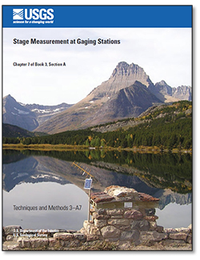Stage Measurement at Gaging Stations
Links
- Document: Report (7.84 MB pdf)
- Related Work: Water Supply Paper 2175 (html) - Measurement and Computation of Streamflow
- Superseded Publications:
- Download citation as: RIS | Dublin Core
Abstract
Stream and reservoir stage are critical parameters in the computation of stream discharge and reservoir volume, respectively. In addition, a record of stream stage is useful in the design of structures that may be affected by stream elevation, as well as for the planning for various uses of flood plains. This report describes equipment and methodology for the observation, sensing, and recording of stage in streams and reservoirs. Although the U.S. Geological Survey (USGS) still uses the traditional, basic stilling-well float system as a predominant gaging station, modern electronic stage sensors and water-level recorders are now commonly used. Bubble gages coupled with nonsubmersible pressure transducers eliminate the need for stilling wells. Submersible pressure transducers have become common in use for the measurement of stage in both rivers and lakes. Furthermore, noncontact methods, such as radar, acoustic, and laser methods of sensing water levels, are being developed and tested, and in the case of radar, are commonly used for the measurement of stage. This report describes commonly used gaging-station structures, as well as the design and operation of gaging stations. Almost all of the equipment and instruments described in this report will meet the accuracy standard set by the USGS Office of Surface Water (OSW) for the measurement of stage for most applications, which is ±0.01 foot (ft) or 0.2 percent of the effective stage. Several telemetry systems are used to transmit stage data from the gaging station to the office, although satellite telemetry has become the standard. These telemetry systems provide near real-time stage data, as well as other information that alerts the hydrographer to extreme or abnormal events, and instrument malfunctions.
Suggested Citation
Sauer, V.B., and Turnipseed, D.P., 2010, Stage measurement at gaging stations: U.S. Geological Survey Techniques and Methods book 3, chap. A7, 45 p. (Also available at https://pubs.usgs.gov/tm/tm3-a7/.)
ISSN: 2328-7055 (online)
Table of Contents
- Preface
- Abstract
- Introduction and Purpose
- Gage Structures
- Instrumentation
- Typical Gaging-Station Instrumentation Configurations
- Data Retrieval and Conversion
- New Stage-Station Design
- Operation of Stage-Measurement Station
- Safety
- References Cited
| Publication type | Report |
|---|---|
| Publication Subtype | USGS Numbered Series |
| Title | Stage measurement at gaging stations |
| Series title | Techniques and Methods |
| Series number | 3-A7 |
| DOI | 10.3133/tm3A7 |
| Publication Date | October 05, 2010 |
| Year Published | 2010 |
| Language | English |
| Publisher | U.S. Geological Survey |
| Publisher location | Reston, VA |
| Contributing office(s) | U.S. Geological Survey |
| Description | x, 45 p. |
| Public Comments | This edition supersedes USGS Techniques of Water-Resources Investigations 3A–7, 1968, “Stage measurement at gaging stations,” by T.J. Buchanan and W.P. Somers, available at https://pubs.usgs.gov/twri/twri3a7/, and supplements USGS Water-Supply Paper 2175, volume 1, 1982, “Measurement and computation of streamflow: Measurement of stage and discharge,” by S.E. Rantz and others, available at https://pubs.usgs.gov/wsp/wsp2175/. |
| Online Only (Y/N) | Y |
| Additional Online Files (Y/N) | N |


